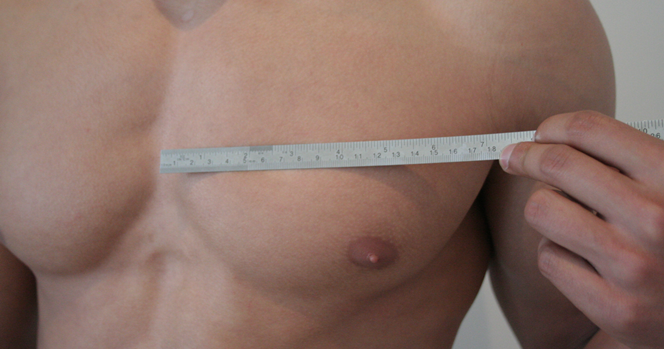
Pectoral Implants
Dr. Ouakil, an aesthetic surgeon in Paris for 30 years, offers pectoral muscle augmentation for men through the placement of retro-muscular cohesive silicone gel implants. Here you will find all the useful and practical information about the procedure of pectoral implants. Pectoral implants provide a natural and effective enhancement of the male torso. These implants are well tolerated and do not require routine replacement.
Who is the pectoral implant procedure for?
The pectoral implant procedure is aimed at both middle-aged men whose chest tone has relaxed and younger men who are already muscular. The added volume effectively reshapes the contour of the pectoral muscle, particularly by enhancing the rounded appearance of the muscle.
Weight training is sometimes unable to develop a satisfactory muscle volume. The placement of pectoral implants allows for this effect.
The goal is to achieve a more defined chest musculature and a more masculine torso.
This projection will respect the natural shape of the male chest and pectoral muscles.
What interventions are possible to increase pectoral volume?
It should be noted that the pectoral muscles are difficult to develop through natural weight training methods; patients often become discouraged from "lifting weights" for hours without a convincing result.
The placement of highly cohesive silicone gel prostheses remains a good and relatively simple solution to the problem.
The placement of pectoral implants is the reference method for increasing the volume of the pectoral muscles.
In the context of associated liposuction, one can take advantage of the autologous biological material represented by one's own fat to give more shape to the pectoral muscles by infiltrating them with their own fat (pectoral lipofilling). This method yields very natural results and can be combined with the treatment of gynecomastia, for example. Pectoral lipofilling can also be performed alone for moderate pectoral augmentation.
An alternative method involves the injection of hyaluronic acid, which allows for shaping the upper part of the muscle without surgery. The injectable quantities at one time remain limited, and the cost is high.
The combination of pectoral implants and lipofilling allows for a composite natural enhancement of the pectorals.
How is the placement of pectoral implants performed?
The placement of pectoral implants is done through a 5 cm incision hidden in a fold of the armpit. A pocket is created to fit the size of the pectoral implant by detaching the pectoralis major muscle, and it is positioned correctly.
The external tissues are closed to stabilize the implant in place.
There is a right pectoral implant and a left pectoral implant that have a mirror shape.
It is semi-rhombus shaped to fit the anatomy of the muscle.
Only one shape is available in France, unlike, for example, the United States where multiple shapes are offered.
Preoperative measurements are taken to choose the most suitable size.
The choice of the pectoral implant must be limited to the exact dimension of the existing pectoral muscle.
It must remain strictly behind the pectoral muscle, even in extreme arm movements, to avoid protruding to the side and risking secondary displacement.
What type of anesthesia can be used and what is the duration of hospitalization during pectoral implant placement?
It is systematically performed under general anesthesia. The hospitalization lasts 24 hours.
How long does the placement of pectoral implants take?
Approximately 1 hour. The detachment behind the pectoral muscle is relatively easy through the axillary incision.
What are the postoperative follow-ups?
They can be painful if the instructions are not strictly followed. Absolute rest for 8 days and systematic intake of preventive analgesic treatment.
Driving is prohibited for 15 days. Avoid any significant arm abduction movements.
Sports involving the shoulder girdle are prohibited for 2 months, particularly weight training. After that, all activities will be allowed without restriction.
Pectoral implants are made of highly cohesive silicone gel, very stable, and do not require routine replacement. However, monitoring every 2 years is mandatory.
What are the potential complications of pectoral implant placement?
Hematoma, which is always possible.
Secondary displacement, which can be prevented by good technique, choosing a well-sized pectoral implant, and adhering to postoperative instructions.
An infection, a rare complication that necessitates the removal of the pectoral implant.
In conclusion
A relatively simple and very effective operation, it remains a procedure with risks if postoperative instructions and indications are not strictly followed. Contrary to popular belief, the placement of pectoral implants is suitable for all types of men.
Pectoral lipofilling combined with the placement of implants represents the best choice and provides the most natural possible result.
